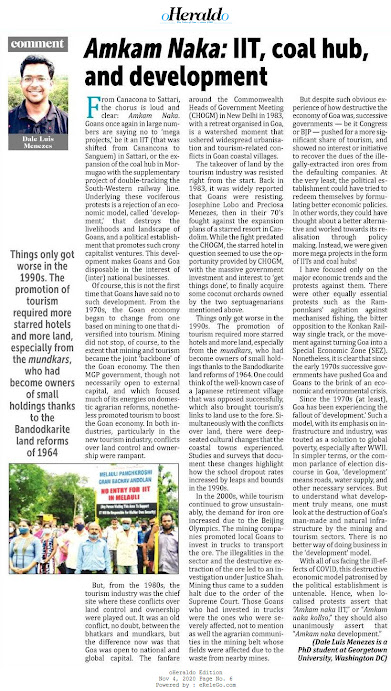From Canacona to Sattari, the chorus is loud and clear: ‘Amka Naka.’ Goans once again in large numbers are saying no to ‘mega projects,’ be it an IIT (that was shifted from Canancona to Sanguem) in Sattari, or the expansion of the coal hub in Mormugao with the supplementary project of double-tracking the South-Western railway line. Underlying these vociferous protests is a rejection of an economic model, called ‘development,’ that destroys the livelihoods and landscape of Goans, and a political establishment that promotes such crony capitalist ventures. This development makes Goans and Goa disposable in the interest of (inter)national businesses.
Of course, this is not the first time that Goans have said no to such development. From the 1970s, the Goan economy began to change from one based on mining to one that diversified into tourism. Mining did not stop, of course, to the extent that mining and tourism became the joint ‘backbone’ of the Goan economy. The then MGP government, though not necessarily open to external capital, and which focused much of its energies on domestic agrarian reforms, nonetheless promoted tourism to boost the Goan economy. In both industries, particularly in the new tourism industry, conflicts over land control and ownership were rampant.
But, from the 1980s, the tourism industry was the chief site where these conflicts over land control and ownership were played out. It was an old conflict, no doubt, between the bhatcars and mundcars, but the difference now was that Goa was open to national and global capital. The fanfare around the Commonwealth Heads of Government Meeting (CHOGM) in New Delhi in 1983, with a retreat organized in Goa, is a watershed moment that ushered widespread urbanization and tourism-related conflicts in Goan coastal villages.
The takeover of land by the tourism industry was resisted right from the start. Back in 1983, it was widely reported that Goans were resisting. Josephine Lobo and Preciosa Menezes, then in their seventies, fought against the expansion plans of a starred resort in Candolim. While the fight predated the CHOGM event, the starred hotel in question seemed to use the opportunity provided by CHOGM, with the massive government investment and interest to ‘get things done’, to finally acquire some coconut orchards owned by the two septuagenarians mentioned above.
Things only got worse in the 1990s. The promotion of tourism required more starred hotels and more land, especially from the mundcars, who had become owners of small holdings thanks to the Bandodkarite land reforms of 1964. One could think of the well-known case of a Japanese retirement village that was opposed successfully, which also brought tourism’s links to land use to the fore. Simultaneously with the conflicts over land, there were deep-seated cultural changes that the coastal towns experienced. Studies and surveys that document these changes highlight how the school dropout rates increased by leaps and bounds in the 1990s.
In the 2000s, while tourism continued to grow unsustainably, the demand for iron ore increased due to the Beijing Olympics. The result was one of the wholesale destruction of the forested regions of Goa. The mining companies promoted local Goans to invest in trucks to transport the ore. The illegalities in the sector and the destructive extraction of the ore led to an investigation under Justice Shah. Mining thus came to a sudden halt due to the order of the Supreme Court. Those Goans who had invested in trucks were the ones who were severely affected, not to mention as well the agrarian communities in the mining belt whose fields were affected due to the waste from nearby mines.
But despite such obvious experience of how destructive the economy of Goa was, successive governments—be it Congress or BJP—pushed for a more significant share of tourism, and showed no interest or initiative to recover the dues of the illegally-extracted iron ores from the defaulting companies. At the very least, the political establishment could have tried to redeem themselves by formulating better economic policies in the wake of massive scandals and illegalities in these ‘backbone’ sectors. In other words, they could have thought about a better alternative and worked towards its realization through policymaking. Instead, we were given more mega projects in the form of IITs and coal hubs!
I have focused only on the major economic trends and the protests against them. There were other equally essential protests such as the Ramponnkar’s agitation against mechanized fishing, the bitter opposition to the Konkan Railway single track, or the movement against turning Goa into a Special Economic Zone (SEZ). Nonetheless, it is clear that since the early 1970s—that is after Goa was made a part of the Indian Union—successive governments have pushed Goa and Goans to the brink of an economic and environmental crisis.
Since the 1970s (at least), Goa has been experiencing the fallout of ‘development.’ Such a model, with its emphasis on infrastructure and industry, was touted as a solution to global poverty, especially after WWII. In simpler terms, or the common parlance of election discourse in Goa, ‘development’ means roads, water supply, and other necessary services. But to understand what development truly means, one must look at the destruction of Goa’s man-made and natural infrastructure by the mining and tourism sectors. There is no better way of doing business in the ‘development’ model.
With all of us facing the ill-effects of COVID, this destructive economic model patronised by the political establishment is untenable. Hence, when localized protests assert that “Amka naka IIT,” or “Amka naka kollso,” they should also unanimously assert that “Amka naka development.”
(First published in O Heraldo, dt: 5 November, 2020)

No comments:
Post a Comment